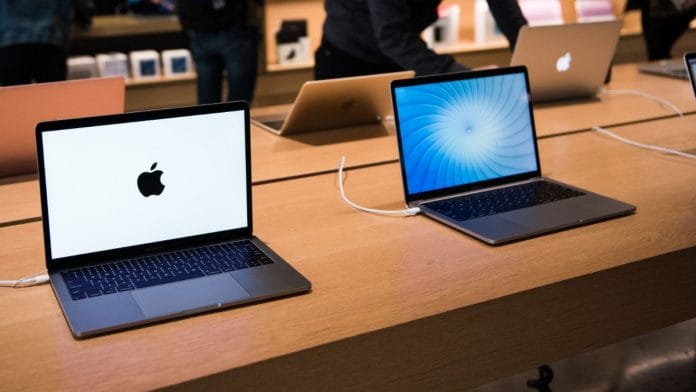Los Angeles: Apple Inc. is preparing to release several new Mac laptops and desktops with faster processors, new designs and improved connectivity to external devices, accelerating the company’s effort to replace Intel Corp. chips and leapfrog rival PC makers.
The overhaul encompasses a broad range of Macs, including Apple’s higher-end laptop, the MacBook Pro; the laptop aimed at the mass market, the MacBook Air; and its desktop computers, the Mac Pro, iMac and Mac mini, according to people familiar with the matter.
Redesigned MacBook Pros are expected to debut as soon as early this summer, said the people, who requested anonymity to discuss an internal matter, followed by a revamped MacBook Air, a new low-end MacBook Pro and an all-new Mac Pro workstation. The company is also working on a higher-end Mac mini desktop and larger iMac. The machines will feature processors designed in-house that will greatly outpace the performance and capabilities of the current M1 chips, the people said.
Apple plans to launch the redesigned MacBook Pros in 14-inch (code name J314) and 16-inch screen (J316) sizes. They’ll have a redesigned chassis, magnetic MagSafe charger and more ports for connecting external drives and devices. Apple is also bringing back the HDMI port and SD card slot, which it nixed in previous versions, sparking criticism from photographers and the like.
Apple on Tuesday said the new 24-inch iMac will be available in stores on May 21. The shares were mostly unchanged.
PC shipments jumped 32% in the first quarter, Gartner Inc. said last month, the fastest year-over-year growth since the firm began tracking the market in 2000. Apple was the fourth-leading seller with 15% of the U.S. market, an increase from 12% in the quarter a year earlier, and 8% globally.
The Mac line of products has been a growing contributor to the company’s revenue, generating $9.1 billion in Apple’s January-March quarter, or 10% of total sales.
Apple last fall started replacing Intel processors with M1 chips, based on the same technology in the iPhone and iPad. Those eat less power and let the Mac run the same apps as the mobile devices. Now more powerful iterations of the company’s silicon are coming to the Mac line. They’ll have more graphics and computing cores, boosting speeds for everyday tasks and such intensive work as video editing and programming.
For the new MacBook Pros, Apple is planning two different chips, codenamed Jade C-Chop and Jade C-Die: both include eight high-performance cores and two energy-efficient cores for a total of 10, but will be offered in either 16 or 32 graphics core variations.
The high-performance cores kick in for more complex jobs, while the energy-efficient cores operate at slower speeds for more basic needs like web browsing, preserving battery life. The new chips differ from the M1’s design, which has four high-performance cores, four energy-efficient cores and eight graphics cores in the current 13-inch MacBook Pro.
The chips also include up to 64 gigabytes of memory versus a maximum of 16 on the M1. They’ll have an improved Neural Engine, which processes machine-learning tasks, and enable the addition of more Thunderbolt ports, which let users sync data and connect to external devices, than the two on the current M1 MacBook Pro.
Apple to likely phase out Intel MacBook Pro
This will be the first time professional Macs get in-house main processors; eventually the company will stop selling the high-end Intel MacBook Pros.
Apple has also been working on a more powerful version of the Mac mini (code name J374) with the same chip as the next MacBook Pro. It’s expected to have four ports versus the pair available on the current low-end version and to sit above the current entry-level M1 Mac Mini. Apple could delay or cancel the new mini’s launch — as it has in the past — but eventually the company will likely replace the Intel-equipped version it now sells.
An Apple spokeswoman declined to comment.
Buyers of the high-end Mac Pro desktop planned for next year will likely have a choice of two processors that are either twice or four times as powerful as the new high-end MacBook Pro chip.
Codenamed Jade 2C-Die and Jade 4C-Die, a redesigned Mac Pro is planned to come in 20 or 40 computing core variations, made up of 16 high-performance or 32 high-performance cores and four or eight high-efficiency cores. The chips would also include either 64 core or 128 core options for graphics. The computing core counts top the 28 core maximum offered by today’s Intel Mac Pro chips, while the higher-end graphics chips would replace parts now made by Advanced Micro Devices Inc.
The new Mac Pro has been in the works for several months and is expected to look like a smaller version of the current design, which was launched in 2019, Bloomberg News has reported. Apple has also been working on a larger iMac with in-house processors, but development of that version was paused months ago in part to let Apple focus on releasing the redesigned 24-inch model this month.
For a redesigned, higher-end MacBook Air planned for as early as the end of the year, Apple is planning a direct successor to the M1 processor. That chip, codenamed Staten, will include the same number of computing cores as the M1 but run faster. It will also see the number of graphics cores increase from seven or eight to nine or 10. Apple is also planning an update to the low-end 13-inch MacBook Pro with that same chip.
As early as 2022, Apple plans to replace the last remaining Intel part with an in-house version. Apple’s current M1 Macs still use an Intel component known as a USB Retimer, which helps power the USB-C and Thunderbolt ports on its computers. –Bloomberg
Also read: Global chip crisis worsens, Ford, BMW, Honda cut production






